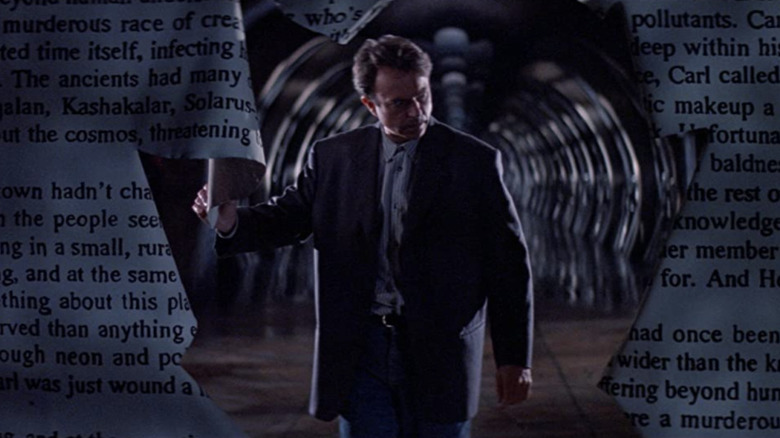Studio Notes On In The Mouth Of Madness Had Director John Carpenter Shocked
John Carpenter is a filmmaker who boasts several stone-cold classics to his resume. Not only did he more or less invent the modern slasher movie with "Halloween," but he's also responsible for titles such as "Escape From New York," "The Thing," "They Live," "Prince of Darkness," "Big Trouble in Little China," and many more. Carpenter is pretty much retired from feature filmmaking at this point, and his as-of-now final film, "The Ward," isn't so great. However, there's one later-period Carpenter movie that I consider to be one of his best works: "In the Mouth of Madness." It received mixed reviews when it opened in 1994, and it wasn't much of a box office hit, but in my humble opinion, it's pretty damn great — and scary, too.
The film tells the story of famous horror author Sutter Cane, who is like a mash-up of Stephen King and H.P. Lovecraft. When Cane goes missing right before the publication of his latest novel, his publisher hires an insurance investigator (played by the great Sam Neill) to track him down. Neill's character suspects this entire thing is a publicity stunt, but soon his entire perception of reality is turned upside-down when he finds the terrifying details from the missing author's works are bleeding into the real world. It's one of the best Lovecraftian movies that isn't a straightforward Lovecraft adaptation.
As I see it, "In the Mouth of Madness" is a horror classic and I wouldn't change a thing. But according to Carpenter, he got some hair-raising notes on the film from the studio while making the movie.
The studio wanted to cut huge chunks from In the Mouth of Madness
Carpenter likes to have complete control over his movies, and in his early days, he had just that (that's part of the reason his name frequently appeared before the movie's title). But studio interference became a real concern for the filmmaker as his career continued, and apparently, the producers of "In the Mouth of Madness" didn't quite get what Carpenter was going for with his fright flick. While speaking with Variety, Carpenter was asked if he ran into any problems on "In the Mouth of Madness." First, the filmmaker talked about the issues with working with rubber monsters: "Well, when you work with a bunch of rubber, which we did on that film, there are always problems making it not look so ridiculous because it is ridiculous: There's a bunch of rubber moving around!" Then, he moved on to the issue of studio notes.
"That movie had some interesting notes when I showed the final cut to the studio and, oh man," he said, continuing:
"The head of the studio wanted to gut it and throw it out, said it didn't work. And I thought, 'What the hell are you talking about? We can't. This is the movie.' I didn't want to throw out Hobb's End, I was in such shock. I've gotten some great notes. Let me tell you, just great." (Laughs)
Hobb's End refers to a cursed town the main characters find themselves in during the course of the film, and the scenes in Hobb's End comprise a huge chunk of the movie. "Throwing them out," as seems to have been the suggestion from the studio, would've completely ruined the film and blown up the narrative. Thankfully, Carpenter won out in the end, and "In the Mouth of Madness" has stood the test of time to be remembered as one of his great films (at least by me).

